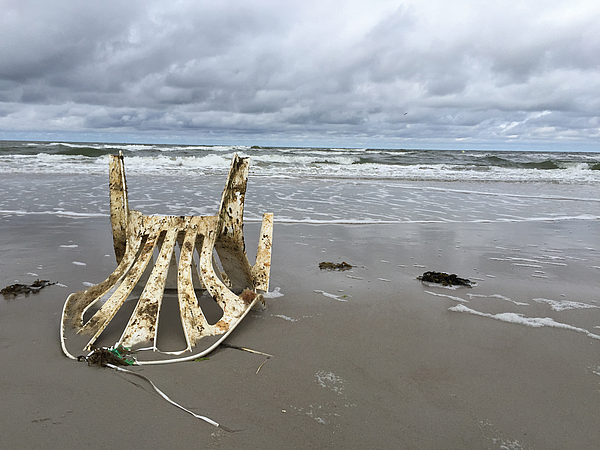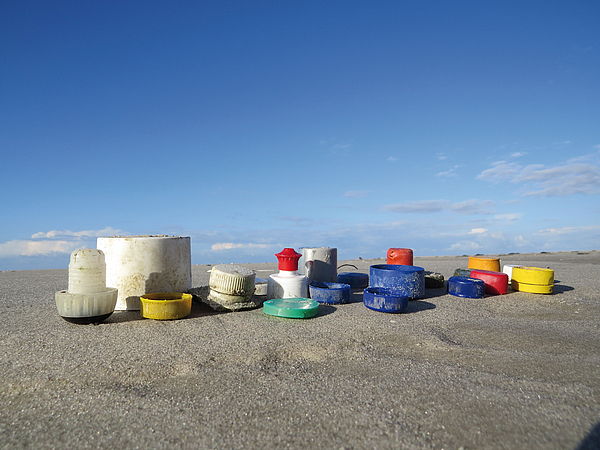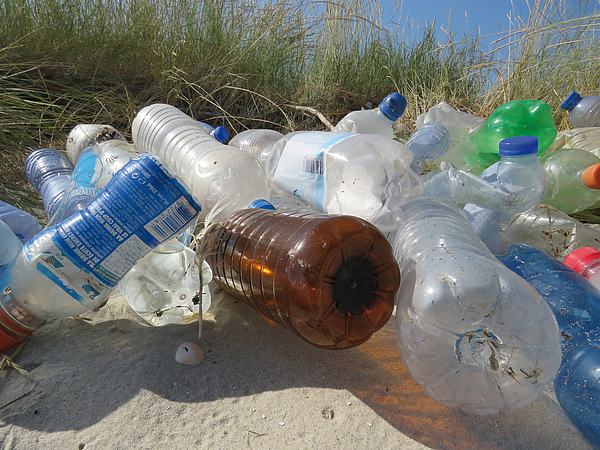

The colours of the large German Eiderstedt peninsula, with its seemingly infinite beach, are soothing – depending on the weather, the sand can be golden or muted in the colours of nature, the sky can be an impressive, brilliant blue or a threatening, dark grey that warns of a turn in the weather, the grasses oscillate between bright green and light grey, sea lavender peppers the dunes with splashes of purple.
Jennifer Timrott

So far, so beautiful. But after the storm the picture changes entirely. Now we see lurid orange, garish yellow and bilious green. The sea has thrown plastic waste onto the beach: drinks and cosmetics bottles, caps, ear plugs, buckets and all manner of fibre material such as ratchet straps and the remains of fishing nets and plastic ropes.
On the sections of the beach frequented by tourists the municipal council does a good job of regularly clearing the waste away, including things that visitors carelessly leave behind or forget: broken balls, sun lotion tubes, cigarette butts, glass and plastic bottles. However, things look very different on the more remote salt marshes, areas where entry is regulated, for example during the seabird breeding season. Jennifer Timrott has the lurid bright colours there particularly in her sights, since she is doing a great deal of work for her beach to stop it from being flooded with plastic waste. On the more remote stretches, it is primarily private initiatives that do the litter picking, and it is clear from the objects they find that they have been in the sea for some considerable time.
Jennifer Timrott is the founder and chair of the “Küste gegen Plastik” (Coasts Against Plastic) association. Collecting rubbish is one of the tasks its members have assigned themselves, but they are not content to stop there: they are also appealing to industry and commerce, and with some success. A retailer in Sankt Peter-Ording banned plastic bags from the checkout over two years ago, and homemade soup can be bought locally in glass containers on a deposit and return system. The association has now also stepped onto the political stage in Berlin: in the Round Table on Marine Litter initiated by the German Environment Agency, the Federal Ministry for the Environment and the Environment Ministry of Lower Saxony, Jennifer Timrott and her team are contributing to the working group on land-based inputs. It is clear that the long-term goal goes much further, however: the initiative is calling on manufacturers to offer products in alternative packaging to plastic, demanding eco-friendly product design and investment in ideas for plastic-free packaging. It would ideally like to see plastic production restricted.
So far, so good. There is no question that if this approach was implemented consistently across the world we would come closer to solving the problem. Consumers would be absolved of responsibility, since they would no longer have a choice.
But is this realistic? Can we turn back the hands of time? Experts in the packaging industry will smile and say no. They will boast of sustainability: lightweighting, reducing energy consumption and decreasing the use of noxious substances. These measures all relate to the manufacturing process, and certainly a lot has been achieved here. But is it not somehow grotesque if sustainable packaging ends up in the ocean and rots there for decades, or – with luck – is collected on a beach and fed back into the cycle? Ms Timrott’s concern is what happens after products are consumed, when drinks bottles, caps and yoghurt pots have served their purpose. For her, her team and the rest of us besides, we will have taken a huge leap forward once recyclability and recycling become mandatory. And of course once closed-loop material cycles are created.

In August, German news magazine ‘Der Spiegel’ dedicated a cover story to saving the seas. Oceans not only have to grapple with plastic waste. The ‘triad of terror’, according to Der Spiegel, is made up of warming, acidification and oxygen depletion. The enormous biotope “contains 97% of all water and almost 80% of all biomass. This stores immense quantities of carbon dioxide and generates the oxygen for every second breath taken.” Saving the ocean sounds like a herculean task and then some. On the other hand, to quote Sylvia Earle, an American oceanographer and environmental activist, we understand more today than any other generation before us, and we should seize this chance to save our seas. The Netherlands-based company Ocean Cleanup has made it its task to collect the plastic waste carpeting the ocean floor. Whether the venture will succeed is uncertain. It is the right approach, though, and an important one too, since the degradation of plastic in the sea not only takes an extremely long time, the poisonous substances it releases accumulate in the food chain. In the words of Der Spiegel: “It is not without irony that the waste a human creates ultimately ends up in his stomach.”

It is not only packaging from Germany and its neighbouring countries that finds its way onto these North Sea beaches. Ms Timrott has, for instance, found PET bottles from China and South Korea. But if she is spared from collecting plastic packaging originating in Germany and its neighbours over the coming years, a big step will at least have been taken on a local scale. Awareness will then hopefully spread to the rest of the world. Plastic packaging has only existed for a few decades. It would be wonderful if, within a much shorter space of time, the material could become globally accepted as a valuable substance to be collected and recycled. Then, not only would the North Sea beach regain its glorious natural colouring, the oceans would have one problem less to contend with.

The Wadden Sea that spans a stretch of the Dutch, German and Danish North Sea coast has been a UNESCO World Heritage Site since 2009 (waddensea-worldheritage).

Jennifer Timrott will be a speaker at the forthcoming PETnology Conference in Nuremberg on 7-8 November. She will also defend her position in the panel discussion ‘Are we green enough?’.

www.petpassionweek.com/petnology-conference-2016
The comPETence center provides your organisation with a dynamic, cost effective way to promote your products and services.

magazine
Find our premium articles, interviews, reports and more
in 3 issues in 2026.


